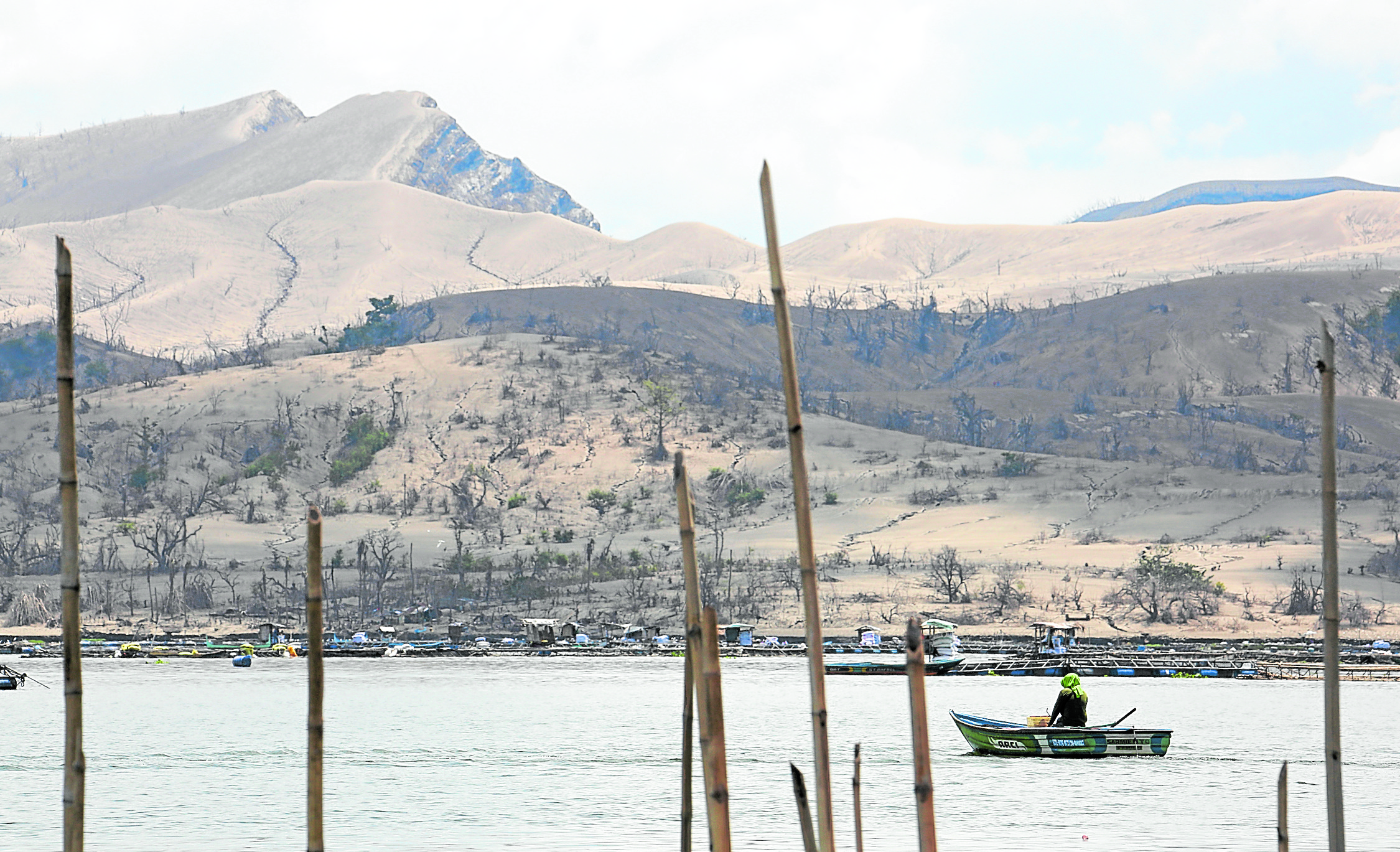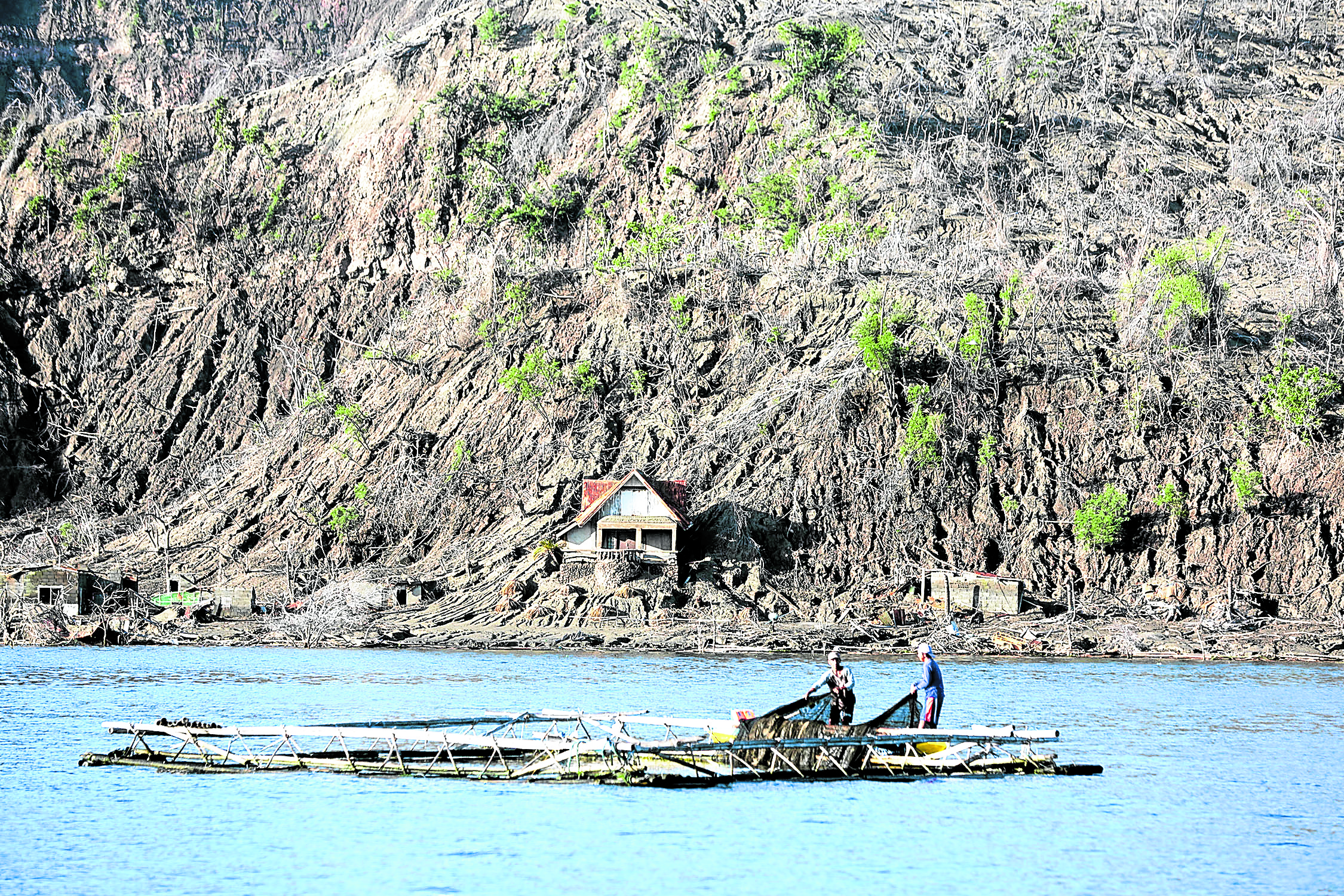Taal communities brace for disaster

DANGER ZONE Taal Volcano Island, “Pulo” to locals who once lived there before the volcano erupted in January last year, is largely deserted after the government declared the area a permanent danger zone. The volcano’s alert status has been raised to Level 2, indicating increasing unrest. —NIÑO JESUS ORBETA
Local governments and disaster response officials in towns surrounding Taal Lake have readied their evacuation plans after the Philippine Institute of Volcanology and Seismology (Phivolcs) on Tuesday raised the alert status on Taal Volcano to Level 2, indicating increasing unrest in the country’s second most active volcano. Taal had been under Alert Level 1, or abnormal status, since March 19, 2020, two months after it rocked to life on Jan. 12, spewing hot volcanic ash and gas, and forcing thousands of residents in Batangas and Cavite provinces to leave their homes. Despite the heightened alert, evacuation is not yet recommended, although Phivolcs warned that the probable magmatic activity beneath the volcano’s edifice “may or may not” lead to an eruption.
Observations by volcanologists showed an increase in volcanic earthquakes, as well as changes in the temperature in the main crater lake and an ongoing ground deformation.
Between Monday and Tuesday, the Taal Volcano Network recorded 28 volcanic tremor episodes, four low-frequency volcanic quakes and one hybrid quake at shallow depths of less than 1.5 kilometers beneath the Taal Volcano Island, locally known as “Pulo.”
Phivolcs said these quakes, which lasted between 3 minutes and 17 minutes, had increased seismic energy compared to previously recorded episodes.
Volcanologists said the total number of volcanic tremor events had risen to 866, since the beginning of increased volcanic activity on Feb. 13.
Article continues after this advertisementIncreased seismic activity
“Overall, seismic activity in the past month indicates increased magmatic and hydrothermal activity at shallow depths beneath the Taal Volcano Island,” read the Taal Volcano bulletin released on Tuesday morning. Volcanologists also noted the increased temperature and acidity in the main crater lake. The latter, they said, is caused by the sustained volcanic gas input into the shallow hydrothermal system that feeds into the lake.
Article continues after this advertisement“[This signifies the] degassing of magma intruded at depth during the January 2020 eruption,” Phivolcs said.
Real-time monitoring equipment also showed an ongoing slight deformation of the volcano island, as well as a “very slow but steady” inflation or expansion of the Taal region since the end of its eruption last year.
With the increased volcanic activity, Phivolcs reminded the public that Taal Volcano Island is a permanent danger zone, and that entry into the island, especially within the vicinity of the main crater and the Daang Kastila fissure, must be strictly prohibited. The government has declared the volcano island a permanent danger zone and barred the return of residents who had lived off farming, fishing and tourism.
Preparedness
Phivolcs advised local governments to assess previously evacuated barangays around Taal Lake for road damage and accessibility, and to strengthen preparedness, contingency and communication measures in case of renewed unrest.
“Residents of these barangays are advised to be always prepared, to keep calm and listen to information only from trusted or verified sources,” it added.
Peter John Mirania, Talisay’s disaster risk reduction and management official, said those involved in disaster response held an emergency meeting after the bulletin was issued.

LAKEWORK Owners and caretakers of fish cages in Taal Lake have been allowed to return to Taal Volcano Island for limited periods so they can check their cages and feed their stock. —GRIG C.MONTEGRANDE
“Our plans are ready,” he said. On Feb. 16, more than 60 people, all Talisay residents who are fish cage owners and workers, were evacuated by Coast Guard personnel and policemen from the island after a series of earthquakes were recorded on the volcano. They were allowed to stay on the island for short periods so they could tend to their fish cages.
Since then, a police desk was set up on Talisay’s lakeshore to serve as a registration station for those who wanted to go to Pulo to feed their fish stock. No one is allowed to sail without passing through the police desk. A report from the Cavite Provincial Information and Communication Affairs Department posted on its Facebook page said officials from Agoncillo, Laurel, Lemery and Talisay in Batangas on March 2 met with their counterparts from Alfonso, Amadeo, General Emilio Aguinaldo, Indang, Magallanes, Mendez, Silang and Tagaytay City in Cavite to discuss an evacuation plan.
Cavite Gov. Juanito Victor Remulla reiterated to local officials the importance of preparedness amid the continued unrest of Taal. Remulla said more than 52,000 evacuees from Batangas sought temporary shelters in Cavite when Taal erupted last year.
“This prompted the provincial government to craft a disaster preparedness measure as the activity of Taal Volcano cannot be predicted,” he said.
Based on the evacuation plan, evacuees from Laurel will be accommodated in Alfonso while those from Talisay will be received in Silang and Indang. Agoncillo evacuees will stay in Mendez and Tagaytay City and those from Lemery will go to Magallanes, General Emilio Aguinaldo, Amadeo and Tagaytay City.